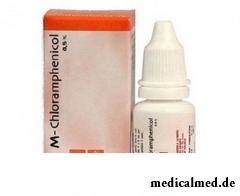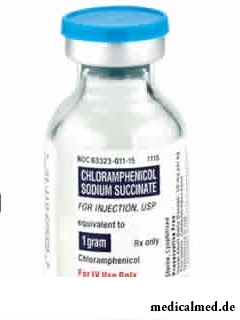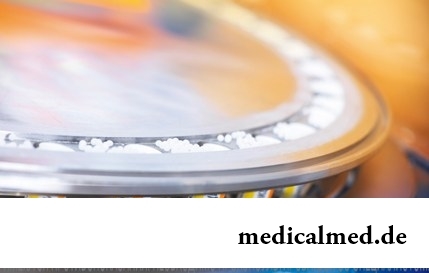





Chloramphenicol
Application instruction:
Chloramphenicol is the medicine having antibacterial properties. It is intended for treatment of various infectious  diseases. Chloramphenicol is widely used in pediatric practice and in ophthalmology.
diseases. Chloramphenicol is widely used in pediatric practice and in ophthalmology.
Pharmacological action
Chloramphenicol represents antibacterial drug of a broad spectrum of activity. It effectively influences various gram-negative and gram-positive microorganisms including on causative agents of a purulent infection, dysentery, typhoid, meningococcal infection. In therapeutic concentration drug has bacteriostatic action.
According to the instruction Chloramphenicol is applied to treatment of infectious and inflammatory diseases which causative agents are spirochetes, brucellas, rickettsiae, chlamydias and hemophilic bacteria. Concerning acid resisting bacteria, protozoa, clostridiums, a pyocyanic stick Chloramphenicol is poorly active.
This medicine resistance of microorganisms develops rather slowly. Against the background of treatment by Chloramphenicol cross other antibacterial agents resistance usually does not develop.
According to the instruction Chloramphenicol at intake is well and quickly soaked up. It well gets into cerebrospinal fluid and breast milk.
At use in ophthalmology of eye drops of Chloramphenicol therapeutic concentration of drug in a cornea, an iris of the eye and in a vitreous is created. However in a crystalline lens medicine does not get.
Form of production of Chloramphenicol
This drug is produced in the form of the tablets containing 0,25 and 0,5 g of active agent.
For topical administration in ophthalmologic practice Chloramphenicol is used in the form of eye drops with the content of active agent in 1 ml – 2,5 mg (0,25%).
Chloramphenicol for injections is produced in the form of the powder packed into sterile bottles on 0,5 and 1,0 g.
Chloramphenicol synonyms
This drug is produced also under other trade names: Levomycetinum, Laevovinisolum. Synthomycin, etc. Synonyms of Chloramphenicol have just the same indications and contraindications to use, as well as Chloramphenicol.
Indications to use
Chloramphenicol is applied to treatment:
• Generalized forms of a salmonellosis;
• Paratifov;
• Tularemias;
• Rikketsiozov;
• Brucellosis;
• Typhoid;
• Hlamidiozov;
• Meningitis.
According to the instruction Chloramphenicol can be used also for treatment of other infectious diseases provided that they are caused by microorganisms, sensitive to it. It can be used also at inefficiency of other antibacterial agents, and also if their use at the specific patient is impossible because of individual hypersensitivity.
In ophthalmology Chloramphenicol is applied to treatment:
• Conjunctivitis;
• Blepharitis;
• Keratitis.
Contraindications
• Individual intolerance;
• Some skin diseases (fungal infections, psoriasis, eczema);
• Hemopoiesis function oppression.
According to the instruction Chloramphenicol is contraindicated to pregnant women, nursing mothers. It is not necessary to use this drug for treatment of newborn children since it can cause development of the "gray syndrome" which is shown nausea, a meteorism, a hypothermia, gray-blue skin color because of the progressing cyanosis, disturbances of breath and symptoms of cardiovascular insufficiency in them.
Chloramphenicol: application instruction
Drug is taken  inside for half an hour to food. The adult usually appoints about 0,25 – 0,5 g to reception each six hours. For treatment of very heavy infections Chloramphenicol is appointed four times a day on one gram. In this case it is necessary to control carefully functions of kidneys, a liver and a hemopoiesis.
inside for half an hour to food. The adult usually appoints about 0,25 – 0,5 g to reception each six hours. For treatment of very heavy infections Chloramphenicol is appointed four times a day on one gram. In this case it is necessary to control carefully functions of kidneys, a liver and a hemopoiesis.
The Chloramphenicol dosage for children is calculated proceeding from age of the child and his body weight.
Duration of a course of therapy by Chloramphenicol makes 7-10 days. In need of and on condition of good tolerance of drug the course can be prolonged by the patient up to 14 days.
In ophthalmology eye drops with Chloramphenicol apply to instillations, digging in in a conjunctival sac two drops from 3 to 5 times a day. Treatment is carried out during one – two weeks.
Side effects
Use of Chloramphenicol can lead to development of various side effects:
• Reticulocytopenia;
• Leukopenia;
• Thrombocytopenia;
• Anemia;
• Allergic reactions;
• Decrease in visual acuity and hearing;
• Confusion of consciousness;
• Psychomotor excitement;
• Visual and auditory hallucinations;
• Dispepsichesky phenomena.
Emergence of side reactions demands drug withdrawal. Synonyms of Chloramphenicol have similar side effects.
Special instructions
Chloramphenicol should not be used for treatment of the acute respiratory diseases, quinsies and any infectious processes proceeding benign. Also you should not use this medicine with the preventive purpose.
Carefully patients who received radiation therapy or treatment by cytostatic drugs earlier should appoint Chloramphenicol.
Against the background of treatment by Chloramphenicol reception of alcoholic beverages since it can lead to development of disulfiramopodobny reaction (nausea, vomiting, a hyperemia of integuments, reflex cough, tachycardia, a convulsive syndrome) is inadmissible.
In the course of treatment by Chloramphenicol it is necessary to control a pattern of peripheral blood regularly.
It is not necessary to use at the same time Chloramphenicol with cytostatic drugs, anticoagulants of indirect action and barbiturates.
Chloramphenicol storage conditions
Chloramphenicol is released from drugstores without recipe of the doctor. A period of storage of tablets – three years, powder for preparation of solution for injections – four years, eye drops – it is possible to store two years, however the opened bottle no more than a month.
Our kidneys are capable to clear three liters of blood in one minute.

The popular expression "run from a heart attack" became the motto of the people supporting active lifestyle. Moreover, run became peculiar...
Section: Articles about health
During foot walks blood moves on vessels more actively and one and all bodies are supplied with a large amount of oxygen. It affects the state of health of the person very positively....
Section: Slideshow
Aging — natural and inevitable process. Over time our skin loses elasticity, on it saggings are formed, the face form loses former clearness. The procedure of nitevy lifting (nitevy tightening) can successfully solve this problem. In order that it is better to get acquainted with this popular procedure, we will tell you 6 cognitive facts about it....
Section: Articles about health
EKO, or extracorporal fertilization - a method of treatment of infertility which became the reason of a set broken mines in due time...
Section: Articles about health
Each person has easy indispositions which he transfers "standing", trying not to ask for medical care. Arguments at the same time are adduced same: "it is a trifle, itself will pass", "I have too many important issues", "there are no wish to spend time on...
Section: Articles about health
Coffee - the tonic loved by many for the invigorating aroma and deep taste. Having the stimulating effect, coffee increases working capacity, promotes concentration of attention, fights against drowsiness and improves mood. Statistically, about 30% of inhabitants of the planet regularly use coffee, from them more than 8% are "coffee-achievers" - the persons using more than 3 cups of drink a day....
Section: Articles about health
Partial and the more so full loss of hearing significantly reduces quality of life. Difficulties with communication lead to loneliness and замкн...
Section: Articles about health
Feeding by a breast - the integral part of ideal motherhood allowing to come into contact with the kid and to create to it healthy immunity since early years. Nevertheless, this important process in life of mother and child can be saddened laktostazy − by a delay of milts...
Section: Articles about health
Life does not indulge the modern woman special emotional comfort and carelessness. The fatigue, troubles at work, misunderstanding in a family and various illnesses immediately affect a condition of hair and skin. And there is a wish to look safe and attractive so! Substantially competently picked up diet can improve situation....
Section: Articles about health
The fatigue, sleep debt, disturbances of food, bad mood, vagaries of the weather – all these circumstances badly are reflected in our vn...
Section: Articles about health
All parents are ready to what the baby often and pisat much. Since then, as the absorbing diapers strongly became current, keeping of the kid in dryness does not represent any problems. But if the grown-up kid continues to urinate in panties, parents of a nacha...
Section: Articles about health
According to World Health Organization, every third inhabitant of Earth has excess weight, and every tenth has obesity. The reason of this phenomenon, according to specialists, roots in one not very comforting fact: most of people consume much more calories, than it is necessary. How it turns out what we overeat? Why it is so difficult to refuse an excess portion tasty or additives? Let's try to find out what factors prevent us to eat food with reasonable moderation....
Section: Articles about health
Bees – really unique beings. Practically all products of their life activity are used by the person. Since the most ancient times from...
Section: Articles about health
Each failure in work of bodies and systems of a human body is, as a rule, shown by the whole complex of symptoms. In particular, malfunctions with health often cause emergence of cosmetic defects in the form of rashes on a face. Experienced doctors know that локализац...
Section: Articles about health
For the time being the perspective of heart diseases seems to most of people remote and foggy. But sooner or later practically each adult faces extremely unpleasant feelings: sudden stethalgia. To be consoled at this time in a thought of what for a heart attack still early, will hardly turn out: if the person is impressionable, he, as a rule, has feeling of panic and fear of fast death. And meanwhile, it is very often possible to confuse pains with cardiac pains невралгическог...
Section: Articles about health
Some people consider what for medicine of the 21st century of secrets in the field of health of the person almost does not exist. It absolutely not so. Than Bol...
Section: Articles about health
It seems, quite recently you brought the baby from maternity hospital, but time flew by, and here it is already going to join the first in life children's collective. How to prepare the child for visit of a garden? What needs to teach him to facilitate process адап...
Section: Articles about health
One of the major chemical processes happening in a human body are oxidation reactions. They go with participation of fats and carbohydrates which we receive from food, and the oxygen getting to us from air. A main goal of such reactions is obtaining the energy necessary for life activity. Unfortunately, as a result of these processes dangerous by-products – so-called free radicals are allocated. To minimize harm which they can cause to the person neo...
Section: Articles about health
For the help to doctors in the choice of optimal solutions for treatment of various diseases the Cochrane scientific organization (Cochrane) will see off совм...
Section: Articles about health
Physical activity is necessary for normal functioning of a human body. At a lack of the movement joints cease to function, muscles atrophy, cardiovascular activity is broken and the metabolism worsens. Modern городс...
Section: Articles about health
Run - one of the most available and effective ways to revitalize the organism. Knowing about its extraordinary advantage, each of us at least once tried to make jogs, but only the few made these occupations regular. In spite of the fact that in jogging (easy jogging), apparently, there is nothing difficult, the beginning runners often make mistakes which lead to complete cessation of trainings. Let's consider 10 useful tips for beginners who will allow them to make regular п...
Section: Articles about health
History of mankind contains several tens of epidemics whose emergence was compared by eyewitnesses and historians to doomsday. With...
Section: Articles about health
White teeth and the Hollywood smile – a dream of many people. Long time was considered that the plaque on teeth and change of their color – destiny of those who incorrectly eat smokes and badly brushes teeth. But the paradox is available: at everything the variety of toothpastes existing today...
Section: Articles about health
The climax, or menopause is the normal process of the termination of genital function of the woman which is followed by serious hormonal changes in an organism. Usually the menopause begins at the age of 50-55 years, but characteristics of this process are very individual. Factors of earlier approach of a climax are irregular sex life, numerous abortions, addictions, existence of endocrine, autoimmune and gynecologic diseases, frequent stresses and excessive hobby of diets...
Section: Articles about health
Each woman has preferences in the field of use of those goods which help us to look good, feel се...
Section: Articles about health
Statistically, can only one of ten of our compatriots brag of a decent condition of an oral cavity. Six teeth affected with caries are the share of the average Russian. For comparison, this indicator for Europeans almost six times exchanges...
Section: Articles about health
80% of women at least once to lives complained of discomfortable feelings to breasts, consolidations and nagrubaniye. These are mastopathy symptoms. The mastopathy is characterized by change of a ratio between ferruterous and connective tissue tissues of mammary glands. It can lead to formation of cysts (a cystous mastopathy), gland consolidation (a fibrous mastopathy), or a combination of these processes (a fibrous and cystous mastopathy)....
Section: Articles about health
